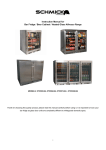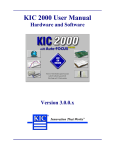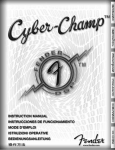Download INSTALLATION & SERVICE MANUAL (ISM) A5FGN(T
Transcript
Low and Medium Temperature Narrow Depth Glass Door Display Merchandisers INSTALLATION & SERVICE MANUAL (ISM) For Model Numbers: A5FGN(T), A5FG(T)BB • A5NGN(T), A5NG(T)BB Manual Part no. 10000004 ISM Document Information Issue Date February 2009 ~ Revision Mark First Edition ~ Replaces n/a Details of each revision can be found on page 32 of this manual. Individual product ISM’s are designed as supplements to Tyler’s General Installation & Service Manual. Copies of current ISM’s are available on the Tyler Refrigeration website in the Quick Reference section. Tyler Refrigeration • 1329 Lake Street, Niles Michigan 49120 USA ph: 800.992.3744 • fax: 269-684-9802 • email: [email protected] • www.carrier-tyler.com A5FGN(T), A5FG(T)BB, A5NGN(T), A5NG(T)BB TABLE OF CONTENTS Service . . . . . . . . . . . . . . . . . . . . . . . . . . . . . . . . . .28 Evaporator Expansion Valve Defrost Heater Element . . . . . . . . . . . . . . . . . . . .30 Heater Element Removal Evaporator Fans Air-Curtain Velocity Fan Removal Ballasts Fluorescent Lighting Optional Lighting . . . . . . . . . . . . . . . . . . . . . . . . .31 INTRODUCTION . . . . . . . . . . . . . . . . . . . . . . . . . . . . .3 Delivery Inspection . . . . . . . . . . . . . . . . . . . . . . . . . .3 Packaging . . . . . . . . . . . . . . . . . . . . . . . . . . . . . . . . .3 Location . . . . . . . . . . . . . . . . . . . . . . . . . . . . . . . . . . .4 INSTALLATION Leveling . . . . . . . . . . . . . . . . . . . . . . . . . . . . . . . . . . .5 Case Movement . . . . . . . . . . . . . . . . . . . . . . . . . . . . .8 Drain Line . . . . . . . . . . . . . . . . . . . . . . . . . . . . . . . . .9 Lineup Assembly . . . . . . . . . . . . . . . . . . . . . . . . . . .10 Front Edge Trim Replacement . . . . . . . . . . . . . . .31 Kickplate and Bumper . . . . . . . . . . . . . . . . . . . . . . .12 REVISION LOG . . . . . . . . . . . . . . . . . . . . . . . . . . . . .32 Under-Case Return Airflow . . . . . . . . . . . . . . . . . . .13 EQUIPMENT WARRANTY . . . . . . . . . . . . . . . . . . . .33 REFRIGERATION Refrigerant Piping . . . . . . . . . . . . . . . . . . . . . . . . . .14 Temperature Control Adjustment . . . . . . . . . . . . . . .14 Leak Check > Evacuation > Charging . . . . . . . . . . .15 Line Sizing Tables . . . . . . . . . . . . . . . . . . . . . . . . . .16 ELECTRICAL . . . . . . . . . . . . . . . . . . . . . . . . . . . . . . .19 Optional Electrical Wiring . . . . . . . . . . . . . . . . . . . . .19 Wiring Diagrams . . . . . . . . . . . . . . . . . . . . . . . . . . .20 DEFROSTING Defrost Setting and Controls . . . . . . . . . . . . . . . . . .25 Electric Defrost Operation . . . . . . . . . . . . . . . . . . . .26 Gas Defrost Operation . . . . . . . . . . . . . . . . . . . . . . .26 Limit Thermostat . . . . . . . . . . . . . . . . . . . . . . . . . . .26 Coil Parts Breakdown . . . . . . . . . . . . . . . . . . . . . . .27 USER INFORMATION AND SERVICE User Information . . . . . . . . . . . . . . . . . . . . . . . . . .28 Cleaning Shelf Location Shelves Loading the Case Light Switch Case Thermometer Case Lineup Combinations and Length Chart . . .29 Tyler Refrigeration • Niles Michigan USA 2 February 2009 Manual Part #: 10000004 INTRODUCTION Information contained in this manual pertains to both low-temperature and medium-temperature display merchandisers, including models: A5FGN A5FGNT A5FGBB A5FGTBB A5FGNE A5FGNTE A5NGNE A5NGNTE A5NGN A5NGNT A5NGBB A5NGTBB Consult the factory if your store exceeds these test conditions. Delivery Inspection These display cases were carefully tested in the factory, inspected and properly packed to ensure delivery in the best possible condition. The equipment should be uncrated and checked for damage immediately upon delivery. DAMAGE MUST BE NOTED AT TIME OF DELIVERY AND ALL CLAIMS FOR DAMAGES MUST BE FILED WITH THE TRANSPORTATION COMPANY NOT WITH TYLER. The carrier will supply necessary report and claim forms. The use of the name “merchandiser” and “case” are used interchangeably and have the same meaning. Also, the term “freezer” refers to the A5F series of frozen glass door merchandisers, while the term “cooler” represents the A5N medium temperature versions. Packaging Tyler has made every effort to provide refrigeration equipment of the highest quality using state-of-the-art components. Merchandisers are built with the thickest insulation in the industry with a high-efficiency evaporator coil. Each case within a lineup is labeled to identify the lineup and joint. Labels use a number and letter designation (Figure 1). The number indicates the lineup. The letter indicates the case joint. Case joints begin with the letter A at the left most joint in the lineup, when looking at the front of the lineup. The joint for two cases has the same number-letter designation. Back-to-back cases have a unique designation. The leftmost joint in the lineup when looking at the front of the case is labeled 1-A. The joint on the back of the case is 1-A1. Potential case features include: • Brushless D.C. electronic motors or PSC or shaded pole fan motors • T8 fluorescent lamps • LED lighting • Standard-energy, low-energy or no-energy doors Insulated dividers are factory installed to separate low and medium temperature cases. They are also used to join different case models. Factory installed “Plexi” glass dividers separate refrigeration circuits. These display cases were designed and tested using the following industry standards: • ASHRAE Standard 72-2005 – Method of Testing Commercial Refrigerators and Freezers (ANSI Approved) • ARI 1200- Performance Rating of Commercial Refrigerated Display Merchandisers and Storage Cabinets (ANSI Approved) • UL 471- Commercial Refrigerators and Freezers (ANSI Approved) (equipment certified by ETL) • NSF 7- Commercial Refrigerators and Freezers (ANSI Approved) (equipment certified by NSF) The first case in the lineup (with it’s right side labeled A) has a packet attached to the door handle that contains the manual, special instructions for installing ordered options, and touch up paint if the cases are custom painted. Every other case in the lineup has a packet attached to the door that contains the specific information for that case. The packing slip is taped to each case’s right hand door. Bumpers and kickplates are shipped on top of the case. Shelves for the case are tie wrapped and blocked into the individual cases. Other accessories like, drain traps, drain pans, condensate evaporating pans, and hat channels are shipped in the case that require the parts. ASHRAE 72-2005 specifies the test conditions for the equipment. It includes the ambient conditions of 75° F dry bulb and 55% RH. It also specifies the door opening requirements for the performance test. Doors are opened six times in one hour for 6 seconds. The door opening test period is for 8 hours during one 24-hour performance test. As an example a 5-door case will have 240 door openings during one 24-hour test. February 2009 Materials for joining cases include caulk, joining bolts, splices and T or J strips. These parts are supplied in cases that have a left-side insulated divider or no left end. The parts are bagged and taped to the coil covers. The T and J strips are tied to the shelves. 3 www.carrier-tyler.com Introduction A5FGN(T), A5FG(T)BB, A5NGN(T), A5NG(T)BB and merchandisers set back-to-back should be positioned to allow a minimum of 2" - 4" of space behind the back of the unit(s). This will allow necessary air to circulate behind the display case(s). Higher humidity stores with minimal air circulation require a 4" gap. Location These cases must not be installed in the direct rays of the sun or near a source of radiant heat. Be certain that the floor under the installation is of sufficient strength to prevent sagging. Out of level conditions will result in reduced performance. Wall merchandisers (those set with their backs to a wall) Figure 1: Case label information Tyler Refrigeration • Niles Michigan USA 4 February 2009 Manual Part #: 10000004 INSTALLATION A Leveling Merchandisers must be installed perfectly level to allow efficient operation of the refrigeration coils and complete drainage of defrost water. Since a level area is seldom available, the following steps are recommended to insure a level installation. 1. Measure off and mark on floor the exact dimensions of the case lineup. (Check blueprints). 2. Snap a chalk line at the locations for the front and back positions of the base rails (Figure 2-A). B 3. Mark locations of all joints (front and back). 4. Using a laser or transit, find the highest point along both base rail position lines. Using the high point as a reference, mark the difference directly on the floor to each joint (front and back)(Figure 2-B). 5. If you plan on using optional hat channels to raise the case height, place them under each pair of bases (Figure 3). Three and four door hat channels will be angled slightly to support the front and rear bases. C 6. Place the required number of shims under each base or optional hat channel at each joint (front and back) to equal the highest point. Ca s The A5FGN(T) and A5NGN(T) 2 through 5 door merchandisers have segmented bases mounted at the ends and under the center section of the case. Back-to-Back versions have full bases that run from front to back and are located at the ends and under the center sections of the case. The A5FGN(T)E and A5NGN(T)E crown-ends have segmented bases that run front-to-back. eF ron t Shim Placement Ca se Fro n t Figure 2: Leveling cases prior to joining 7. Tape all shims in place (Figure 2-C). 8. Correctly orient the shims under the base or channel. Both corners of the base must be supported by shims to prevent the base from buckling (Figure 4). 9. Place additional support shims under all other bases or hat channels (Figures 5A, 5B & 5C). Base 10.If you’ve purchased seismic restraints, specific instructions for attaching those restraints are included in your document package. These instructions should be read and followed before the line up is assembled. Shim Base Shim Hat section Figure 3: Typical hat channel locations February 2009 5 www.carrier-tyler.com Installation Figure 4: Shims under bases and case Figure 5A: Base Locations Tyler Refrigeration • Niles Michigan USA 6 February 2009 Manual Part #: 10000004 Figure 5B: Base Locations for 2-5 door back-to-backs Figure 5C: Base Locations for end case February 2009 7 www.carrier-tyler.com Installation A5FGN(T), A5FG(T)BB, A5NGN(T), A5NG(T)BB The following fork-lift dimensions must be maintained to avoid damaging the case when it is lifted: Case Movement The back-to-back (BB) cases are shipped with wood planks that allow the use of pipe rollers. These wood planks should be removed after the case is moved to its final location (Figure 6). 2-Door Merchandisers Forks must extend from 26" to no more than 30" under the case. All cases have steel protective support plates under the ends (not under insulated dividers). They are designed to protect the end from Johnson bar damage. 3-Door Merchandisers Use 48" long forks. Forks must extend from 39" to no more than 43" under the case. Use the following methods to move the cases. 4 and 5 Door Merchandisers Model Use 48" long forks. Forks must extend from 44" to 47" under the case. Fork lift Johnson Furniture Pipe Safe (case) from ends bar Dolly Rollers jacks A5F(N)GN(T) A5F(N)G(T)BB A5F(N)GN(T)E * Fork blades wider than 4" will not fit into the bases. For low shipping height applications such as the use of the optional Remote Condenser Unit (RCU), Tyler has optional expandable bases. As shipped, the base is 1-3/4" tall. It is attached with spacers that allow the base to slide away from the bottom of the case creating a gap that allows the use of a 1-1/2" thick fork-truck blade. * Fork-lift from the rear Care should be taken when moving the cases. The doors should be secured so they cannot open while the case is moved. Only experienced certified fork truck drivers should use fork trucks to move the cases. The case should only be lifted off the floor as high as necessary for transport. The fork truck should be driven slowly avoiding any abrupt motions or bumps. Figure 6: Removing wood planks Tyler Refrigeration • Niles Michigan USA 8 February 2009 Manual Part #: 10000004 Drain Line The drain is located at the center of the case in the floor pan. The drain can be reached by removing the center coil covers and then removing a fan motor. The 1" PVC drain outlet is located at the center-front of the case behind the kickplate. Install the tee to the outlet pipe and a drain trap to the tee. Plug the open end of the tee using the clean-out plug supplied with the drain trap kit. The drain line must be pitched away from the case. The tee, drain trap and plug are supplied with the case, and the factory installs a drain support at the front of the case. A trap support is supplied and is field mounted to the case (Figure 7). The drain trap must be level and should be primed with water after installation. Figure 7: Trap Support February 2009 9 www.carrier-tyler.com Installation A5FGN(T), A5FG(T)BB, A5NGN(T), A5NG(T)BB Lineup Assembly 1. Set the first case into the desired position and level it. Run a 1/4" to 3/8" diameter bead of Butyl caulk 1/2" in from both the inner and outer surfaces of the case end. (Figure 8). 2. Push the second case against the end of the first. Level the second case. Remove the left and right end-coil covers and the rectangular pocket hole covers, accessing the holes in the end frames of each case as shown. The bolt kit supplied with the cases includes diagrams of these locations. Install tee-strips between the door frames at case joints (See Figure 9). Use the special screws and nuts provided. 3. Start the joining bolts, but do not tighten them. Begin tightening the bolts at the top rear, working down the back of the case and up the front making sure that the front seams are flush. 4. For NSF case installation, the interior case seams need to be sealed using NSF approved caulk (not supplied) (Figure 10). 5. The end-panel protector support plates should be removed after the cases are set in their final position. Figure 9: T-Strips DO NOT APPLY EXCESS AMOUNTS OF BUTYL SEALANT THAT WOULD CAUSE IT TO SQUEEZE ONTO END FRAME METAL AREAS. Caulk-sealant used to join cases and complete the sealing requirements for NSF compliance should not come in contact with butyl sealant. Apply to clean, dry surfaces free of contaminants that adversely affect adhesion and could change color of sealant joint areas over time. B Procedure for Joining Cases A 1/4" - 3/8" TYPICAL BUTYL SEALANT BEADS 1. Apply two 1/4" to 3/8" wide beads of Butyl sealant, 1/2" in from the inside and outside edges of the foamed insulated ceiling, rear wall, base, and door frame to be joined. Apply to only one case joint to avoid excessive amounts of Butyl sealant that would squeeze out of the joint. Sealant is not applied to the structural steel end frames. After cases are joined, caulk the top and back exterior seams (if possible) at this time. DETAIL A SCALE 1 : 5 DETAIL B SCALE 1 : 5 These procedures are critical! Failure to follow these guidelines will result in a poorly functioning case. This is especially true of freezers. 1/4" - 3/8" TYPICAL BUTYL SEALANT BEADS 2. When joining ends of cases, caulk sealant should be applied in the same like manner for joints. If 4 shipping blocks are installed to inside of base ends, remove them to comply with NSF. Figure 8: Caulking cases to be joined Tyler Refrigeration • Niles Michigan USA 10 February 2009 Manual Part #: 10000004 Figure 10: Required sealing for NSF approved installations February 2009 11 www.carrier-tyler.com Installation A5FGN(T), A5FG(T)BB, A5NGN(T), A5NG(T)BB Installing the Front Kickplate &Bumper (Figures 11A & B) Kickplate and Bumper A custom Tyler cart bumper is standard on all case models and is installed at the bottom front of the case. The assembly is adjustable to compensate for uneven floors. The front kickplate and bumper attaches using 1½" screws attached to support brackets located on the front of the case. The kickplate can be adjusted up and down to fit the height of the floor below it. Installing the End Kickplate (Figure 11A) 1. Starting from the left end of the lineup, attach a Tinnerman clip to each kickplate support. Locate them over the slot in the kickplate support. The end kickplate attaches to small brackets that are affixed to each side of the case. The kickplate can be adjusted vertically to match the height of the floor below it. 2. Attach a kickplate splice to the right side of the front kickplate using the ¾" screw in the lower hole. 1. Attach a Tinnerman clip to the side kickplate support. 3. Lean the kickplate against the kickplate support. 2. Place the end kickplate against the Tinnerman clip on the end kickplate support. 4. Place the bumper assembly on the case by hanging the bumper support onto the bumper hanger. The kickplate should be located behind the bumper support. 3. Install a black 3/4" screw through the end kickplate into the Tinnerman clip. A scratch-awl or similar tool can be used to line up the holes. 5. Install the black 1½" screw through the bumper, front kickplate, kickplate splice, and into the Tinnerman clip. A scratch-awl or similar tool can be used to line up the holes. 4. The front lip of the end kickplate lies behind the front kickplate and is attached with screws to the front kickplate and front-end kickplate supports. 6. Follow these steps to install the next bumper in the Figure 11A: Installing the bumper and kickplate Tyler Refrigeration • Niles Michigan USA 12 February 2009 Manual Part #: 10000004 lineup. A bumper support splice (provided) should be installed between the two cases. Center the splice over the gap using self-tapping screws (provided). Attach the upper portion of the splice using the predrilled holes in the splice. Then with two more screws, attach the lower half. Figure 11B: Bumper and Kickplate Configuration Under-Case Return Airflow To assemble the bumper for under case return airflow, a spacer (provided) must be inserted between the bumper support and kickplate (Figure 12). The spacer is held in place with the standard black assembly screw used to attach the bumper. One 3/8" spacer is required at each screw location (2 spacers on a 2-door, 3 spacers on a 3door, etc.). 1. To ease installation, hook the bumper to the case and position the kickplate. Then pull the bottom edge of the bumper forward, hold the spacer in place, and then insert the assembly screw through the bumper, spacer, kickplate, bumper bracket and into the Tinnerman clip. 2. With the spacers in place, air will be allowed to flow between the bumper and kickplate and then underneath the case. The target airflow rate under the case should be 50 cfm/door. Figure 12: Bumper / Under-case air flow February 2009 13 www.carrier-tyler.com A5FGN(T), A5FG(T)BB, A5NGN(T), A5NG(T)BB REFRIGERATION General Unless otherwise specified, the liquid and suction connections are made inside the case under the evaporator fan/coil cover. Refrigerant piping may enter the case through the front left bottom, the left rear bottom of case or the left rear top of case. The copper pipe should not touch or rub on the edges of the sheet metal. After connections have been made, the refrigeration access hole in the case must be sealed completely with aerosol¬ dispensed Urethane insulation or equivalent (i.e.: Great Stuff). Penetrations made in sheet metal baffles should also be sealed (Figure 13). Refrigerant Piping Correct refrigeration line sizing and installation is essential for proper system operation (see wiring diagrams on pages 16-18). A P-trap must be installed at the bottom of all vertical suction risers (Figure 14). Various risers are available as a factory installed option. Figure 13: Penetration sealing When two or more case sections are connected to one compressor, the main liquid and suction line for the group should be run through the cases and be brought out through the refrigeration outlet of one case only. The factory recommends one riser per circuit/system for hot gas defrost when using top back refrigeration exit. Circuit risers are available as a factory installed option. Insulate the tubing for at least 20 feet from the case outlet. On 30" wide door cases with suction lines over 1-3/8" diameter, a P-trap made with 45° elbows is required (Figure 14). A piping chase in front of the fan shroud allows the refrigerant lines to be run through the right or left end frame. selected with adequate contact capacity for the switching load. In rack systems, an evaporator pressure-regulating valve may be used to control the evaporating temperature. Piping should not be placed near the electric defrost heaters. The defrost heaters on the 30" door cases will grow one inch to the left of the coil when they reach operating temperature. When factory installed, the temperature control is located toward the right end of the case behind the black kick plate. The sensing bulb is located under the coil cover on the back side of the fan shroud. It can be wired in series with the low pressure (L.P.) control. It can also be used in a pump-down system by wiring it in series with the liquid solenoid valve. A thermostat is shown in Figure 15. The settings (See Figure 16) are approximate due to variations in gauge accuracy, differences in compressor efficiency, line pressure drop, and super heat settings. Before making adjustments for store or stocking conditions, make sure the super heat is set between 6°F and 10°F. Close coupled systems typically run at the higher end of this range to avoid flood back. Temperature Control Adjustment The compressor should be installed as close as possible to the cases to reduce pressure drop. Install a shallow trap at the bottom of the riser. The suction and liquid lines may be taped together to form an external heat exchanger. Discharge-air temperature probes for electronic case controllers may be installed in many different customer specified locations including, but not limited to, honeycomb, ceiling pocket cover, rear wall, and return air. The best location for the liquid line drier is inside the freezing compartment. However, it may be installed near the compressor for easy maintenance. Install moisture indicating sight glass at the outlet end of the drier. A low pressure or temperature control can be used to control case temperature. The control should be Tyler Refrigeration • Niles Michigan USA 14 February 2009 Manual Part #: 10000004 Leak Check > Evacuation > Charging After all of the refrigeration piping and system components have been assembled, the entire system must be pressurized and checked for leaks. When the system is leak free, evacuate with a deep vacuum pump. Triple evacuation to a minimum of 500 microns and nitrogen sweep is recommended. After the system has been thoroughly evacuated of all moisture and noncondensable gas, charge the system with the proper refrigerant, using “hi-side/low-side” charging techniques. Figure 14: 45 degree elbow suction line Figure 15: Temperature control Figure 16: Temperature Settings for R404a Refrigerant Condensing Unit Cut-in Cut-out (psig) (psig) Discharge Air Temperature Cut-in Cut-out (°F) (°F) Return Air Temperature Cut-in Cut-out (°F) (°F) Application Evaporator Temp (°F) Frozen Food -7 35 24 +3 -3 +6 0 Ice Cream -16 27 16 -3 -12 -3 -9 Medium Temp. +28 Note: These set points may require optimization for your applications to prevent short-cycling or delayed cycling. February 2009 15 www.carrier-tyler.com Refrigeration A5FGN(T), A5FG(T)BB, A5NGN(T), A5NG(T)BB R-404a Line Sizing Tables for Tyler A5 Frozen Foods Merchandisers (-7° Evap. Temp.) Tyler Refrigeration • Niles Michigan USA 16 February 2009 Manual Part #: 10000004 R-404a Line Sizing Tables for Tyler A5 Ice Cream Merchandisers (-16° Evap. Temp.) February 2009 17 www.carrier-tyler.com Refrigeration A5FGN(T), A5FG(T)BB, A5NGN(T), A5NG(T)BB R-404a Line Sizing Tables for Tyler A5 Medium Temp. Merchandisers (+28° Evap. Temp.) Tyler Refrigeration • Niles Michigan USA 18 February 2009 Manual Part #: 10000004 ELECTRICAL is not installed in the liquid line. CAUTION ! The power to operate each display case is connected at each cases’ disconnect switch. The power to operate the condensing unit is connected at the condensing unit. There are no interconnecting wires between the condensing unit and display case. There are interconnecting wires that need to be connected between the cases. The liquid line solenoid valve needs to be installed in the common liquid line before the liquid is distributed to the cases. DISCONNECT POWER TO THE CASE BEFORE SERVICING ELECTRICAL COMPONENTS TO AVOID PERSONAL INJURY AND DAMAGE TO THE UNIT. Figure 17 shows the typical wiring diagram for a freezer equipped with electric defrost, Figure 18 shows the typical wiring diagram for a freezer equipped with hot gas defrost, and Figure 19 shows a medium-temperature cooler with time-off defrosting. Each case ships with a wiring diagram located in the electric box that shows the exact wiring of the case. The controls operate the system as a pump down defrost. When the display case begins defrost, the liquid line solenoid valve, fans and anti-sweat heaters are deenergized. The defrost heaters are energized. The compressor continues to run and pumps down the coil. There are many control options available for multiple case defrost systems. Wiring diagrams and instructions can be obtained by contacting the Tyler Refrigeration Service Department. The master case contains the time clock. Interconnecting case wiring allows the master case to control the satellite cases. When defrost is initiated in the master case, it sends an electrical signal to each satellite case to energize the defrost relay and initiate a defrost in all of the cases. A second set of interconnecting wires are connected in series between each of the cases. Each case defrost heater is de-energized when the coil reaches the defrost termination temperature. An additional signal is relayed to the next case indicating that the termination temperature has been reached. When all of the cases have reached termination temperature, the defrost termination circuit is complete and the defrost is terminated. External wiring should be sized according to the amperage rating stamped on the serial plate. The serial plate is located on the ceiling inside the left-hand door. Typical electrical values are shown on specification sheets for each of these cases in the bag attached to the case or are available at the Tyler Refrigeration website (www.carrier-tyler.com). All internal wiring has been completed at the factory. Cases with standard wiring have their control wires terminated in the electrical compartment located behind the kickplate at the right end of the case. A terminal block has been used to simplify field connections. An electrical box is mounted on the top of the unit for cases equipped with the optional top mount electrical connections. The liquid line solenoid is energized at the end of the defrost cycle and the defrost heaters are de-energized. The suction line pressure rises and the compressor starts. When the evaporator reaches operating temperature, the delay thermostat (klixons) will close, energizing the fans and anti-sweat door heaters. All wiring must comply with the National Electrical Code and all local codes. After installation of the equipment, correct operation of the electrical circuits and controls and defrost operation and termination should be verified. All operating voltages and amperages should be measured and recorded. Optional Electrical Wiring Master-Satellite Connection The “master-satellite” connection system allows one condensing unit to be connected to multiple cases. Figures 20 and 21 shows typical diagrams for this system. All of the display case controls including the disconnect switch, time clock, temperature control, and defrost temperature control are installed behind the kick plate and pre-wired. The liquid line solenoid is pre-wired but February 2009 19 www.carrier-tyler.com Wiring Diagram Figure 17: Electric Defrost A5FGN(T), A5FG(T)BB Tyler Refrigeration • Niles Michigan USA 20 February 2009 Wiring Diagram Figure 18: Hot Gas Defrost A5FGN(T), A5FG(T)BB February 2009 21 Manual Part #: 10000004 www.carrier-tyler.com Wiring Diagram Figure 19: Time-off Defrost A5NGN(T), A5NG(T)BB This wiring diagram for A5NGN(T) cooler merchandisers is applicable to both master and satellite cases. The diagram shows a Defrost Time Clock, Temperature Control, and Solenoid Valve. These are required only on the master case. The satellite case would only require terminal blocks for lights, fans, and anti-sweats. Field-install from the master to the satellite wires to the respective terminal blocks. Tyler Refrigeration • Niles Michigan USA 22 February 2009 A5FGN(T), A5FG(T)BB Master / Satellite Wiring Diagrams (low-temp) Figure 20: Master (Controller) February 2009 23 www.carrier-tyler.com Master / Satellite Wiring Diagrams (low-temp) Figure 21: Satellite (Controlled) Tyler Refrigeration • Niles Michigan USA 24 February 2009 Manual Part #: 10000004 DEFROSTING Preferred Termination: For optimal performance, Tyler recommends a temperature-terminated defrost, using a defrost termination thermostat or probe sensing the coil temperature. General Periodic defrosting to keep the coil free of frost is accomplished automatically by a time clock only in mediumtemperature coolers, or used in conjunction with an electric or hot gas defrost in low-temperature freezers. A5FGN and A5FGNT door case has the probe located at the right hand side of the coil in the center of the bottom row of tubes. Defrost Settings and Controls Off-Cycle Defrost The A5FGNE and A5FGNTE case has the probe located at the right hand side of the coil in the top row of tubes. Medium temperature coolers are typically defrosted by using an “off-cycle defrost”. During an off-cycle defrost, refrigeration to the cases is halted, but the evaporator fans continue to run. Frost is melted by the warmth of the display case’s internal air. Typically, anti-sweat heaters and display lights operate during defrost. Defrost may be terminated by time (30 minutes) or upon reaching a coil temperature of 43°F. Tyler provides a defrost termination thermostat as standard unless a control system defrost probe is requested. The defrost termination temperature is 50°F. Temperature termination based on coil temperature allows the length of defrost to vary depending on how much frost is on the coil and the defrost heater voltage. Coil frost is a function of shopping patterns, stocking habits, general door maintenance and ambient temperature and humidity. More frost requires a longer defrost. A lower defrost heater voltage extends the defrost period. Electric Defrost Frequency: One electric defrost per day is recommended. Alternate Termination: If it is not possible to terminate the defrost cycle based on a defrost termination thermostat or probe sensing the temperature at the coil, and the only available temperature probe is sensing the discharge air temperature, then the termination temperature should be set to 65°F, zero minutes drip time. Time of day: Nighttime defrosting is preferred to avoid periods of shopping or stocking. Duration: Electric defrost does not require any drip time because Tyler provides a built-in fan delay thermostat. Electric defrost for low-temp and off-cycle for mediumtemp Fail-safe Times: Ice Cream Frozen Food Med. Temp A5FGN(BB) 1/day at 45 mins 1/day at 45 mins A5FGNT(BB) 1/day at 55 mins 1/day at 55 mins A5NGNT(BB) Tyler electric defrost freezers are delivered with the defrost thermostat open-on-rise contacts wired-in series with the defrost heaters. Unless the installer rewires the defrost thermostat, the defrost heater is de-energized when defrosting is complete. Tyler electric defrost freezers are also equipped with a high-limit, snap-disc thermostat that de-energizes the defrost heater if the coil temperature exceeds 80°F to provide a secondary safety termination. 3/day at 30 mins Hot Gas Defrost Frequency: One hot gas defrost per day is recommended. At ASHRAE test conditions and 208 volt defrost heater operation, the typical observed A5FGN 30" door defrost durations are 28 minutes for ice cream and 19 minutes for frozen food. At the same conditions, the typical observed A5FGNT 30" door defrost durations are 39 minutes for ice cream and 26 minutes for frozen food. A5FGN(T)E Crown End defrost durations are 43 minutes. February 2009 Time of day: Nighttime defrosting is preferred to avoid periods of shopping or stocking. Duration: Hot gas defrost requires a 5 minute drip time. 25 www.carrier-tyler.com Defrosting A5FGN(T), A5FG(T)BB, A5NGN(T), A5NG(T)BB The timer starts the gas defrost cycle by energizing a solenoid, reversing valve, or directional valve. The gas is injected from the source into the suction line of the evaporator to be defrosted. The gas flows into the serpentine coil attached to the floor of the case and then into the evaporator. Condensed liquid leaves the evaporator through the side port distributor, through a check valve into the liquid line. (Figure 23). Hot Gas Defrost Fail-safe Times: Ice Cream Frozen Food Hot Gas 1/day at 30 mins 1/day at 30 mins 5 min. drip 5 min. drip Reduced Temperature Gas 1/day at 40 mins 1/day at 40 mins 5 min. drip 5 min. drip General Notes Preferred Termination: For optimal performance, Tyler recommends a temperature-terminated defrost, using a defrost termination thermostat or probe attached to the dump line. • The refrigeration technician should recheck coil condition after one week of retail operations to be certain that the frequency and duration of defrost is adequate for the particular store and locality. For example, if defrost voltage is below 200 volts, additional fail-safe time may be required. Defrost termination thermostats are optional on hot gas or reduced-temperature gas applications. If the cases are so equipped, the defrost termination is 65°F. • When using time terminated defrost, defrost termination thermostat should be wired in series with the defrost heater. Electric Defrost Operation • Defrost termination thermostats may be wired in series for multiple evaporator installations. • Defrost termination thermostats may be used as a digital input for electronic controllers. At ASHRAE test conditions, termination ranges from 1222 minutes. The compressor stops when the defrost is initiated in a non-pump-down system. On pump-down systems, the liquid line solenoid will be de-energized when the defrost is initiated. The clock will energize the 208/230 volt defrost heater, and energize the normally closed 208/230 volt contactor or relay. This de-energizes the 115-volt fans, lights and anti-sweat heaters. If you don’t have a light circuit limit thermostat, the lights will not deenergize. Limit Thermostat Each freezer has factory set limit thermostats (Klixons) attached to the return bends of the coil on the right end of the freezer to regulate the operation of the evaporator fans and anti-sweat door heaters. A limit thermostat is optional for the light circuit. When a limit thermostat is provided in the lighting circuit, the lights will be off during defrost. After the defrost period, the compressor will operate. When the coil temperature reaches +5°F, the fan, light and anti-sweat heater limit thermostats (Klixons) will close, starting the fans, lights and anti-sweat heaters (Figure 22). IMPORTANT! OPERATION OF THE LIMIT THERMOSTATS CAUSES THE EVAPORATOR FANS, FREEZER LIGHTS, AND ANTI-SWEAT DOOR HEATERS TO REMAIN OFF UNTIL THE COMPRESSOR IS OPERATING AND THE COIL TEMPERATURE IS BROUGHT BELOW THE THERMOSTAT CUT-IN SETTING (+5°F ). SUPERHEAT MUST BE SET CORRECTLY BY THE INSTALLING CONTRACTOR FOR PROPER THERMOSTAT OPERATION. Gas Defrost Operation Several types of gas defrost methods in conjunction with time actuated, time or temperature terminated defrost timers can be used to defrost the evaporator. The refrigeration system designer and installer are responsible for correct line sizing for effective gas defrost and liquid return from the freezers. Sizing and component selection depend on the type of defrost, size, and location of high side refrigeration system. When the freezer first operates, the fans and lights may cycle off and on a few times until coil temperature is below +5°F. The superheat must be set for proper operation. Tyler freezers equipped for gas defrost consist of a side port distributor and a TXV check valve for coil defrost, and a suction line check valve to bypass hot gas to the serpentine coil. The serpentine coil is attached to the bottom of the pan to ensure pan and drain defrost. Tyler Refrigeration • Niles Michigan USA The 30" door models have a high limit thermostat installed on the coil return bend, wired in series with the defrost heaters. This thermostat opens when the temperature reaches 80°F. 26 February 2009 Manual Part #: 10000004 ITEM NO. PART NAME 1 COIL COVER 2 FAN 3 4 LIQUID LINE 5 FAN HOUSING 6 HEAT EXCHANGER 7 EXPANSION VALVE 8 FRONT HEATING ELEMENT 9 REAR HEATING ELEMENT 10 HEATER CLIP 11 DEFROST TERMINATION PROBE LOCATION SUCTION LINE Figure 22: Coil Parts Breakdown, Electric Defrost ITEM NO. PART NAME 1 COIL COVER 2 FAN 3 FAN HOUSING 4 COIL 5 CHECK VALVE 6 SERPENTINE 7 SLHX HEAT EXCHANGER 8 TXV VALVE 9 HAND VALVE (OPTIONAL) 10 DRIER (OPTIONAL) 11 CHECK VALVE 12 SIGHT GLASS (OPTIONAL) 13 DEFROST TERMINATION PROBE LOCATION Figure 23: Coil Parts Breakdown, Hot Gas Defrost February 2009 27 www.carrier-tyler.com A5FGN(T), A5FG(T)BB, A5NGN(T), A5NG(T)BB USER INFORMATION & SERVICE down to prevent the case lights from cycling off and on. Always turn the light switch off when replacing lamps. User Information Cleaning Case Thermometer Cases should be thoroughly cleaned before start-up and routinely thereafter to maintain a clean appearance. Use mild detergent and warm water (never an abrasive cleaner) to wipe out the inside of the case. Wash down all glass doors with glass cleaner. Do not use any products containing silicon on anti-fog glass coatings. Clean interior glass reduces fogging and increases visibility. The case will remain bright and sparkling with just a few minutes of cleaning each week. Internal components can be cleaned after removal of access panels. The case drain should be regularly cleared of debris and price tags. Cases are typically shipped with 2 thermometers. One thermometer is factory mounted in the discharge air stream. The second thermometer is shipped loose and should be installed in the warmest product location. Specific instructions are packaged with the shipped loose thermometer. Service Cart bumpers must be removed to gain access to drain clean-outs and electrical connections. Disassemble the bumper and kickplate by removing the 2 or 3 metal screws located in the kickplate. The bumper assembly can be lifted up and removed from the case. The kickplate can be removed, exposing the electric tray cover and drain (Figure 11A). Do not use high-pressure water or steam to clean the interior. Shelf Location The shelves are adjustable in 1" increments and may be located in any position for the best display advantage. Be sure shelf clips or brackets are completely seated before installing the shelf. The shelf brackets (for wire shelves only) are stamped with “R” for Right and “L” for left for proper orientation when installing shelves. Evaporator The evaporator coil, located at the bottom-rear of the case is factory assembled with the distributor, expansion valve, and other refrigeration components. To inspect the coil, remove the center or left-of-center coil cover. A small inspection port is located at the rear of the case. To inspect the entire coil, remove the remaining coil covers and raise the evaporator cover. Shelves Tyler manufactures many different styles of shelves, baskets and product stops. The shelves and baskets are placed on the shelf brackets. Some of the baskets may be reversed and used as a typical shelf. Expansion Valve A superheat-adjustable externally equalized thermostatic expansion valve, with a removable strainer and pressure limiting charge, is mounted to the evaporator coil unless otherwise specified. The valve is not preset. Adjust the superheat setting for maximum coil effectiveness. Typical superheat settings are between 6°F and 10°F. Close coupled systems should use the higher superheat setting to minimize the chance of liquid flood back. Loading the Case The case may be loaded with merchandise after it has been operated for at least 24 hours with correct case temperature and proper control operation. While loading the shelves, leave an air space between the top of the merchandise and the shelf above it so the customer can remove the merchandise. The air space allows an air curtain on top of the product. Product should not extend beyond the front of the shelves or block the return air grill. To adjust the expansion valve, remove the right end coil cover. Remove the cap from the bottom of the valve. When looking at the valve stem end, turn the valve stem counterclockwise to decrease superheat. Turn the valve stem clockwise to increase superheat. Measure the suction line temperature at the expansion valve-sensing bulb and compare it to the suction temperature corresponding to the saturated pressure. Make sure that line pressure drop is taken into account. (con’t on p.30) The typical Cantilever shelf load is 170 lbs. with a maximum load of 235 lbs. Note some deflection may occur under higher loads. Light Switch A light switch is located inside the right-hand door. Turn the light switch off during the initial case temperature pull Tyler Refrigeration • Niles Michigan USA 28 February 2009 Manual Part #: 10000004 Case Lineup Combinations and Length Chart Doors in Lineup 2 Door Case 2 1 3 3 Door Case 4 Door Case 5 Door Case 1 4 1 5 1 6 2 7 1 62.13 5 ft 2-1/8 in 92.50 7 ft 8-1/2 in 123.00 10 ft 3 in 153.38 12 ft 9-3/8 in 185.00 15 ft 5 in 1 215.50 17 ft 11-1/2 in 8 2 246.00 20 ft 6 in 9 1 1 276.38 23 ft 3/8 in 2 306.75 25 ft 6-3/4 in 338.50 28 ft 2-1/2 in 10 11 1 2 12 3 369.00 30 ft 9 in 13 2 1 399.38 33 ft 3-3/8 in 14 1 2 429.75 35 ft 9-3/4 in 3 460.13 38 ft 4-1/8 in 492.00 41 ft 15 16 4 17 3 1 522.38 43 ft 6-3/8 in 18 2 2 552.75 46 ft 3/4 in 19 1 3 583.13 48 ft 7-1/8 in 4 613.50 51 ft 1-1/2 in 20 21 4 1 645.38 23 ft 9-3/8 in 22 3 2 675.75 56 ft 3-3/4 in 23 2 3 706.13 58 ft 10-1/8 in 24 1 4 736.50 61 ft 4-1/2 in 5 766.88 63 ft 10-7/8 in 25 26 4 2 798.75 66 ft 6-3/4 in 27 3 3 829.13 69 ft 1-1/8 in 28 2 4 859.50 71 ft 7-1/2 in 29 1 5 889.88 74 ft 1-7/8 in 30 6 920.25 76 ft 8-1/4 in 31 4 3 952.13 79 ft 4-1/8 in 32 3 4 982.50 81 ft 10-1/2 in 33 2 5 1,012.88 84 ft 4-7/8 in 34 1 6 1,043.25 86 ft 11-1/4 in 35 7 1,073.63 89 ft 5-5/8 in 36 4 4 1,105.50 92 ft 1-1/2 in 37 3 5 1,135.88 94 ft 7-7/8 in 38 2 6 1,166.25 97 ft 2-1/4 in 39 1 7 1,196.63 99 ft 8-5/8 in 8 1,227.00 102 ft 3 in 40 February 2009 Total length Total length w/o ends (in.) w/o ends (ft. & in.) 29 www.carrier-tyler.com User Information & Service A5FGN(T), A5FG(T)BB, A5NGN(T), A5NG(T)BB Turn the valve stem only 1/4 turn at a time and allow sufficient time (20 to 30 minutes) for the valve to settle before making any further adjustments. Replace the valve stem cap after the valve super-heat has been adjusted. BE CERTAIN THE VALVE STEM CAP IS WIPED DRY FIRST. operating at all times except during defrosting (lowtemperature only). Fan motors should be replaced with motors having the same characteristics including type, physical size, wattage and RPM. Air-Curtain Velocities Air-curtain velocity for freezers and coolers are affected by stocking levels, coil frost loads, temperature and fan condition. The measurement method also affects the reading. Tyler recommends using an Alnor Velometer Jr., set to the 0-to-800 fpm range. Air velocity should be measured at the back edge of the discharge air honeycomb, at the center of the middle door in the case (other doors have slightly lower velocity). A typical velocity reading is 425 feet per minute (FPM) in a fully-packed freezer (395 FPM for medium-temperature coolers), after the freezer/cooler has defrosted and is pulled down to operating temperature. A typical velocity reading for tall cases is 400 FPM for freezers, and 370 FPM for coolers under the same conditions. Air-curtain velocity in a partially packed freezer is significantly lower because more air exits the back wall duct holes. ! CAUTION ! DISCONNECT POWER TO THE CASE BEFORE SERVICING ELECTRICAL COMPONENTS TO AVOID PERSONAL INJURY AND DAMAGE TO THE UNIT. Defrost Heater Element On 30" door cases one heater is located on the front of the coil and one on the rear of the coil. On wraparound cases, the heater element is located under the coil. The electric wire leads are connected in the junction box behind the front kick rail. Heater Element Removal Defrost heaters for the electric defrost cases are located on the front and rear face of the coil. The front heater is located approximately 1” off the floor and the rear heater is approximately 2” off the floor. The heater is secured to the coil by a number of stainless steel heater retaining clips. Heaters are fastened to the floor on the right hand side of the coil. Remove fasteners holding the heater to the floor. Fan Removal 1. Turn off power to fans. Remove coil cover. 2. Unplug fan from fan power supply plug located on the front face of the fan housing. 3. Remove the fan blade nut and fan blade. The front heater can be removed by pulling the retaining clip away from the coil and sliding the heater out from under the clip. 4. Remove the two mounting bolts and remove the fan assembly from the fan housing. The rear heater can be removed by raising the heater retaining clip. Raise each clip about 2 inches above the coil working from right to left on the coil. Repeat this process until the retaining clips are free of the coil. The heater will slide up with the retaining clip. 5. Remove the three fan motor mounting screws from the back of the fan motor. To remove the defrost element for the A5FGN(T)E Crown End, remove the coil covers. Lift the inner coil cover upward and tip the fan housing forward. This will expose the coil. Remove both fan housing end brackets and center coil supports, then slide out the complete heater pan assembly from under the coil. Slowly lift the heater pan assembly between the coil and fan housing, turning it on edge while lifting. Heaters are installed in the reverse order of how they were removed. Most Tyler case ballasts are located in the door mullion. Ballasts for the Crown Ends are located behind the kickplate. 6. Reverse steps 1 - 5 to install. Ballasts for A5F(N)GN(T)E Crown Ends Fluorescent Lighting T8 lighting systems use a lens to direct light output evenly across the shelves. Turn off power before servicing the lamps. The lens must be removed to access the lamp. The lens must be replaced after servicing for proper operation. Detailed information is contained in the door instruction booklet. Evaporator Fans Air is circulated throughout the case with 115-volt low temperature fan motors. These motors must be Tyler Refrigeration • Niles Michigan USA 30 February 2009 Manual Part #: 10000004 Front Edge Trim Replacement C The metal front edge trim is designed as a removeable protective piece that can help protect the end panel from receiving direct damage. In the event of damage, the edge trim can be removed and a replacement piece reinstalled. The following procedure demonstrates how to replace the edge trim: A A. Back-out and retain the frame screws that secure the “J”-strip that covers the inside edge of the trim piece. If the door hinges on the side of the edge trim that needs replaced, it will be in the way of the frame screws, and will need to be removed first in order to access the screws. B. Use a razor blade to score and remove the clear silicone bead and then remove the Jstrip. Remove excess silicone from the J-strip as needed. NOTE: Take proper precautions when using a sharp razor blade. D. Seat the new replacement edge trim piece by laying the top fold of the edge trim into place first, keeping the trim at an angle away from the panel. Then work the piece into place by pressing both downward and inward, applying even pressure to the trim as you work your way down to ensure a proper seal with the tape. D E B E. Reinstall the J-strip with the screws and apply a new bead of clear silicone to seal the J-strip to the edge trim. C. The edge trim piece is secured to the front with a commercial grade double-sided tape (not supplied by Tyler). To remove the damaged trim, start at the top with a blade or screwdriver and tap out to separate the trim from the end panel. Continue downward by gently prying the piece from the panel until removed. Remove any loose debris or tape and then apply strips of doublesided tape to the front of the end panel and remove the backing from the tape. Make sure the entire surface is covered. February 2009 31 www.carrier-tyler.com A5FGN(T), A5FG(T)BB, A5NGN(T), A5NG(T)BB REVISION LOG This log sheet is intended to track both major and minor revisions to this manual, and to describe what the nature of the revision is. Revision identification is located in the lower right corner of the cover page. Major revisions are lettered alphabetically, dated accordingly, and require reprinting for inclusion with the product at shipment. Minor revisions are denoted after the major revision with a “period” followed by a sequential number, and do not require a printed update. All manuals with any revision changes will be available in electronic PDF format on the Tyler Refrigeration website. Content changes that determine the type of revisions are decided on a case-by-case basis by Tyler internal management. REVISION TYPE DATE MAJOR MINOR Feb 2009 n/a n/a Tyler Refrigeration • Niles Michigan USA DESCRIPTION RESULTS First Edition Printing 32 February 2009 February 2009 33 www.carrier-tyler.com

































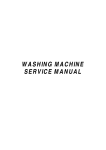
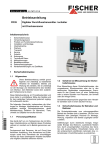
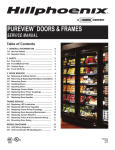

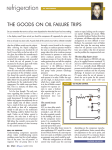

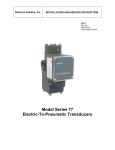

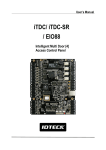
![Intelligent Multi Door [4] Access Control Panel](http://vs1.manualzilla.com/store/data/005798503_1-5afef044e5faf65af74eeb67e2f6e9c7-150x150.png)

